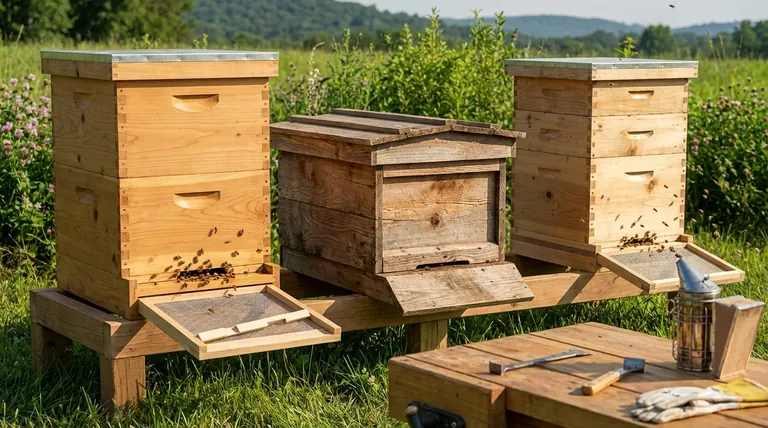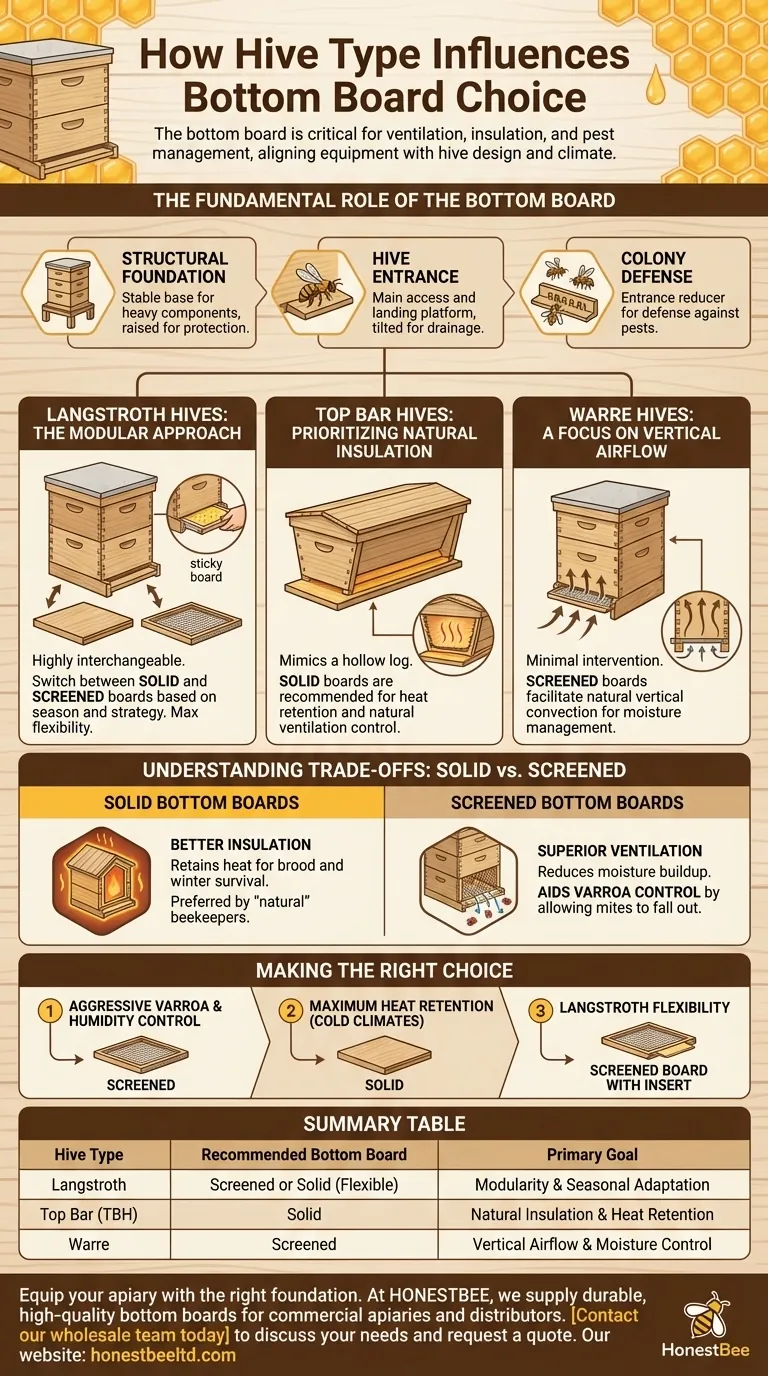Yes, the type of hive directly influences the choice of bottom board. Different hive designs are built around distinct beekeeping philosophies, and the bottom board is a critical component that supports the hive's specific goals for ventilation, insulation, and pest management. Langstroth hives offer modular flexibility, Top Bar hives often prioritize natural insulation with solid boards, and Warre hives typically use screened boards to promote vertical airflow.
Your choice of a bottom board is not just about a floor for the hive; it's a decision that impacts the colony's ability to regulate temperature, manage moisture, and defend against pests. The right choice aligns the equipment with both your climate and the specific design philosophy of your hive.

The Fundamental Role of the Bottom Board
Before comparing types, it's essential to understand the jobs a bottom board performs for the colony. It is a multi-function component that serves as the hive's base.
Serves as the Structural Foundation
The bottom board is the floor of the hive. It provides a stable base for stacking heavy hive bodies and supers.
It is typically placed on a hive stand to raise it off the damp ground, which helps prolong the life of the wooden components.
Creates the Hive Entrance
When a hive body is placed on the bottom board, the space at the front becomes the main entrance and exit for the bees.
This area also serves as a takeoff and landing platform for foragers. Tilting the entire hive slightly forward ensures rainwater drains out and away from this entrance.
Manages Colony Defense
For smaller or newly established colonies, the entrance size is critical. An entrance reducer can be fitted into the opening to make the space smaller.
A smaller entrance is easier for the colony's guard bees to defend against intruders like wasps, robbing bees, or mice.
Connecting Hive Design to Bottom Board Choice
Different hive styles are optimized for different management techniques, and their standard bottom boards reflect this.
Langstroth Hives: The Modular Approach
Langstroth hives are the most common type and are prized for their interchangeability. This philosophy extends to the bottom board.
Beekeepers can easily switch between solid and screened bottom boards depending on the season, climate, or their pest management strategy. This flexibility is a key feature of the Langstroth system.
Top Bar Hives: Prioritizing Natural Insulation
Top Bar Hives (TBHs) are designed to more closely mimic the shape of a hollow log. The management style is often more hands-off.
Consequently, solid bottom boards are generally recommended for TBHs. A solid floor helps the colony retain heat and manage its own ventilation, much like it would in a natural cavity. Screened boards are only considered in exceptionally hot and humid climates.
Warre Hives: A Focus on Vertical Airflow
The Warre hive is designed around the principle of minimal intervention, allowing bees to build their comb downwards as they would in nature.
This design emphasizes vertical airflow to manage moisture. A screened bottom board is a standard component, as it facilitates the natural convection that draws fresh air up through the colony and pushes moist air out the top.
Understanding the Trade-offs: Solid vs. Screened
The debate between a solid and screened bottom board comes down to a simple trade-off: insulation versus ventilation.
The Case for Screened Bottom Boards
The primary benefit of a screened bottom board is superior ventilation. This airflow helps reduce moisture buildup in the hive, which is crucial for preventing mold and disease, especially during winter.
A secondary, but significant, benefit is Varroa mite control. Varroa mites that fall off a bee have a chance to fall completely out of the hive through the mesh, breaking their life cycle.
The Case for Solid Bottom Boards
A solid bottom board provides better insulation. It helps the colony retain the heat they generate, which is critical for raising brood and surviving cold winters.
Many "natural" beekeepers prefer solid boards because they create a more enclosed, log-like environment and allow the bees to manage their own ventilation and propolis seals without a constant draft.
Making the Right Choice for Your Goal
Your decision should be based on your hive type, local climate, and beekeeping philosophy.
- If your primary focus is aggressive Varroa mite management and humidity control: A screened bottom board is the superior choice, especially in warm and humid climates.
- If your primary focus is maximizing heat retention for overwintering in a cold climate: A solid bottom board offers clear advantages in insulation.
- If you are using a Langstroth hive and want maximum flexibility: Use a screened bottom board with a removable insert (a "sticky board"), allowing you to get the benefits of a screen in summer and a solid board in winter.
Ultimately, choosing the right bottom board means understanding how it helps or hinders your colony's natural ability to thrive within the specific hive you have provided.
Summary Table:
| Hive Type | Recommended Bottom Board | Primary Goal |
|---|---|---|
| Langstroth | Screened or Solid (Flexible) | Modularity & Seasonal Adaptation |
| Top Bar (TBH) | Solid | Natural Insulation & Heat Retention |
| Warre | Screened | Vertical Airflow & Moisture Control |
Equip your apiary with the right foundation. Choosing the correct bottom board is crucial for colony health and productivity. At HONESTBEE, we supply durable, high-quality bottom boards and complete beekeeping equipment systems tailored for commercial apiaries and distributors. Let our expertise help you make the best choice for your specific hive type and climate. Contact our wholesale team today to discuss your needs and request a quote.
Visual Guide

Related Products
- Langstroth Screen Bottom Board for Beekeeping Wholesale
- Australian Pine Wood Langstroth Screen Bottom Board for Wholesale
- Professional Galvanized Hive Strap with Secure Locking Buckle for Beekeeping
- HONESTBEE Wooden Bee Escape Board with Triangle Mesh Design for Beekeeping
- Boardman Entrance Bee Feeder Durable Galvanized Steel and Wood Construction for Beekeeping
People Also Ask
- What are the advantages of a screened bottom board? Boost Hive Health with Superior Ventilation & Pest Control
- How should the screened bottom board be used throughout the year? A Guide for Healthy Hives
- How does a screened bottom board assist with temperature control and pest management? A Key Tool for Modern Beekeeping
- What are the benefits of a screened bottom board? Boost Hive Health & Control Varroa Mites
- What is the primary function of a screened bottom board in a hive? Enhance Ventilation & Control Varroa Mites



















